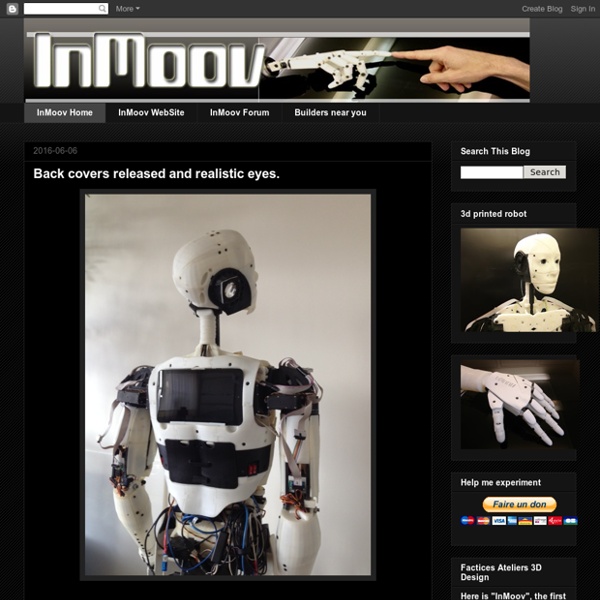



InMoov » open-source 3D printed life-size robot www.odd.org.nz The Atom 3D printed guitar: A guitar inspired by the patterns of oil coalescing on water, with an internal atom with spinning electrons. The bodies are printed, using Selective Laser Sintering, by 3D Systems in the USA, on an sPro 230 SLS system. The material being used for these guitars is Duraform PA which is a very strong form of Nylon. The resolution for the prints was 0.1mm (which means that each layer that makes up the guitar body is 0.1mm thick). The guitars feature a wooden inner core (choices of Mahogany or Maple, etc.) that links the neck to the bridge, which allows us to customize the sustain and tone of the instrument to suit the musician, and a number of options for hardware, etc. Price: US$3500, incl hard case, excl shipping. This includes the following example specifications: Below are pictures of some of the details of the guitar: And, to show the historical progression of our designs, below are pictures of a few different early iterations: Atom Black - Green Cheers Olaf
InMoov – open-source 3D printed life-size robot DIY main robotique contrôlée par un gant et Arduino In total, this project will cost about $100-150, depending on where you get some of the parts. Here's the parts list: 5x MG946R Servos (or equivalent - MG995 or MG996 should work too. I've had a bit of trouble with the range of motion, so servos that support more degrees of rotation would be better) - I got mine from hobbyking.com, but for a less expensive option I'd go with eBay (they come directly from China, so shipping may take longer). 5x 4.5 inch flex sensors - I got mine here: 1x small breadboard 1x battery connector - something like this: Hot glue Super glue Sandpaper (I used 431 grit) - a Dremel tool with a sanding head would also work Needle and thread A power drill A soldering iron Access to a 3D printer ...And you're ready to start!
Travesseiro | Mais de 100 Modelos | Mobly Uma boa noite de sono reflete no nosso cotidiano, por isso, investir em qualidade na hora do descanso é um detalhe que fará toda a diferença. Além da escolha de uma boa cama, outros acessórios também são importantes, como os jogos de cama , edredons , cobertores e claro, um bom travesseiro . O travesseiro é um dos principais acessórios para cama e pode nos trazer conforto e qualidade durante o sono. Portanto, investir no travesseiro ideal é investir no bem estar. Para isso, a Mobly reservou para você mais de 100 modelos de travesseiros para ajudar a sua escolha, além das diversas opções de material, como os de algodão , pluma , pena e espuma , há também diversos tamanhos. Veja também aqui na Mobly, outros acessórios para deixar o seu descanso ainda mais agradável, são diversas opções de cobertores , lençóis , colchas e muito mais, confira!
Finger Starter – InMoov Before printing all the parts you should print the CALIBRATOR, to check if your parts will fit together. If you have a very hard time putting those parts together, you need to review your printer calibration settings. This is going to be interesting!! For connections and power supply you can see HERE. The pulling rods I use on this tuto is a fishing nylon, but it is not what works the best because it tends to stretch overtime. Now let see what we have printed and how we are going to do that. Redrill the sides hinges holes with a 3mm drill. The inside hinges holes should be redrilled with a 3.5mm drill. So the inside hinges of the finger should also be done with a 3.5mm drill. Note the finger parts have numbers printed for a easier assembly. Depending on the material you have used to print there is different ways to glue the parts together. If you have PLA prints, a two components epoxy glue is really good but you can also use Zap-A-Gap glue. Glue together part 3 and 4. Now lets see the servo.
La conception d'un robot minisumo FrédéricGiamarchi Enseignant en électronique La conception d’un robot minisumo permet de réaliser un robot ludique, mais c'est aussi l'occasion de vérifier la validité de ses choix techniques en se mesurant à d’autres lors de rencontres animées mais toujours amicales. Les tournois de robots minisumo sont des moments très attendus au Japon et aux États-Unis pour leur caractère futuriste. La conception d'un robot minisumo passe par l'électrique de l'intérieur par exemple. © Frédéric Giamarchi Voici quelques éléments permettant de détailler la démarche du projet : approche pédagogique, choix technologiques et stratégies possibles pour espérer sortir vainqueur lors de ces rendez-vous. À vos outils... FUNDO BIONIQUE • Comment méduser l’aéronautique Voler, l’homme en a toujours rêvé. Aujourd’hui, il ne trouve plus l’inspiration dans le ciel, mais dans les océans. The Economist 16 avril 2014 | Partager : D ans l’aéronautique surtout, la nature est souvent source d’inspiration pour les ingénieurs. Le désir de s’élever dans les airs à la manière des oiseaux a soufflé aux frères Wright la solution à leur problème : comment contrôler une machine volante plus lourde que l’air ? En la dotant d’ailes incurvées. C’est ce à quoi pensent être parvenus Leif Ristroph et Stephen Childress, de l’université de New York, en s’inspirant d’un modèle naturel assez différent. En quête de stabilité Mais, au lieu d’une ombrelle complète semblable à celle d’une vraie méduse, leur invention se compose de quatre ailes en forme de feuille. Chaque paire d’ailes opposées est mise en mouvement par des tiges en fibre de carbone reliées à un petit moteur électrique. Il ne serait pas difficile de l’équiper d’une batterie et de le laisser s’envoler.
Yahoo